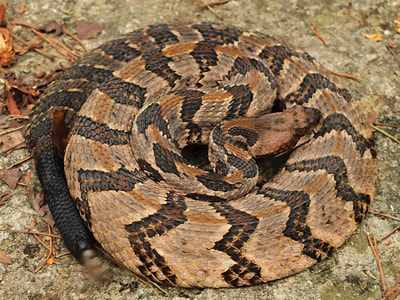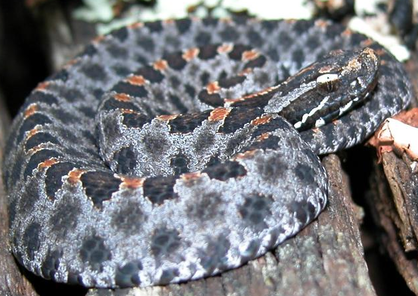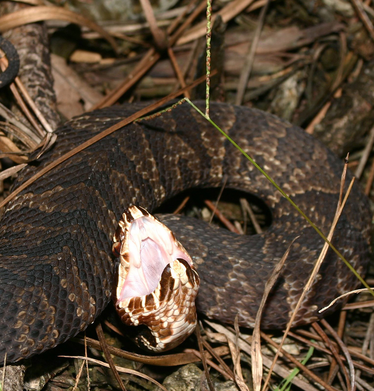Venomous Snakes in Florida
Florida is home to about 50 species of native snakes, six of which are venomous (snakes are not poisonous—"poisonous" refers to something that is toxic when ingested). The venomous species include five pit vipers (eastern diamondback rattlesnake, timber rattlesnake, pygmy rattlesnake, copperhead, and cottonmouth) and the coral snake. The five species of pit vipers all share several characteristics. The pupils of their eyes are vertical (cat-like) and they have a deep facial pit between each eye and nostril. These characteristics can be difficult to see unless a snake is examined closely, so do not rely on them to differentiate venomous from non-venomous species. Florida's pit vipers have blocky, triangular heads that are distinctly broader than their necks. Relative to their length, these species are heavy-bodied snakes.
|
Eastern Diamondback Rattlesnake
Diamondbacks are the largest, most dangerous and most feared venomous Florida snake. They're not endangered, but dwindling habitat is a threat to them. If you come across a 6-foot rattler, keep in mind that it can strike from a distance of 4 feet, about as long as a typical shovel. It occurs throughout Florida in a variety of dry habitats, such as pinelands, scrub, and golf courses. Eastern diamondback rattlesnakes have bold markings down their backs that include a row of large, dark diamonds with brown centers and cream-colored borders. The scales of this species are strongly keeled, giving these snakes a rough appearance. |
|
Timber Rattlesnake
The timber rattlesnake (a.k.a. canebrake rattlesnake) has a relatively small range in the state; it is normally only found in northern Florida as far south as Gainesville. This species prefers moist pinelands, river bottomlands, and hammocks. Timber rattlesnakes can grow to five feet or longer. These snakes usually have a pinkish-gray to tan body color (although some are very dark colored) with prominent, irregularly shaped, dark marks and bands. A reddish-brown stripe runs along the middle of the back of timber rattlesnakes. Pygmy Rattlesnake Pygmy rattlesnakes are the smallest of Florida's venomous snake species. Adults rarely exceed 20 inches in length. Pygmy rattlesnakes range throughout the state and occur in many different habitats that include pine flatwoods, oak scrub, open pinelands, and palm hammocks. This is one of the most commonly encountered venomous snakes that occasionally is found in residential neighborhoods. Pygmy rattlesnakes have a dark facial band that runs from each eye to the rear of the jaw. Their bodies are covered with numerous dark blotches with a row of darker blotches running down the middle of the snake's back. |
|
Cottonmouth
Cottonmouths are venomous semi-aquatic snakes often referred to as “water moccasins.” The name comes from the white or pinkish interior of their mouth. The cottonmouth is the most aquatic of Florida's venomous snakes and occurs throughout the state. It may look similar to other watersnakes, but differ in that cottonmouths have vertically elliptical (cat-like) pupils, whereas water snakes have round pupils. If the head is viewed from directly above, the eyes of cottonmouths cannot be seen, whereas the eyes of watersnakes are visible. Cottonmouths typically rest with their heads elevated off the ground and tilted upwards at an angle. Cottonmouth venom causes immense swelling and pain while causing tissue damage. A cottonmouth bite often comes with extra infections since the snake eats carrion and accessed your bloodstream with its fangs. |
|
Copperhead
Also referred to as a Highland Moccasin, copperhead snakes are easily recognizable by the skin pattern on their back, which looks like an hourglass band, which can be dark brown or almost black. In Florida, copperheads occur only in the Panhandle, primarily in the western tip and along the Apalachicola River and its tributaries. Their dens are often near the borders of marshes, creeks, rivers and lakes. Copperhead snakes frequently hibernate in dens made up of rocks. They also often den inside logs and in holes carved out by mammals. Other typical den spots for these snakes are stone walls, heaps of sawdust, stumps and caves. While they usually stay on the ground, copperheads will sometimes climb into low bushes or trees in search of prey or to bask in the sun. |
|
Coral Snake
The coral snake is often confused with the scarlet kingsnake, however, the coral snake has a black snout with red and yellow touching bands of color. They are thin and long and are generally f found throughout Florida, mostly in dry habitats, including hardwood hammocks, pinewoods, swamp edges, and suburban neighborhoods. It spends most of its time buried under loose leaf litter or logs or underground in stump holes or small burrows. They inject venom by a chewing motion. Just remember the rhyme when it comes to these two snakes… “Red touch yellow, kill a fellow. Red touch, black, friend of Jack.” |







